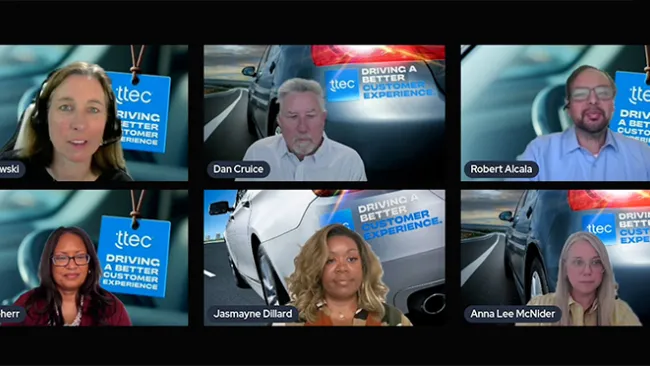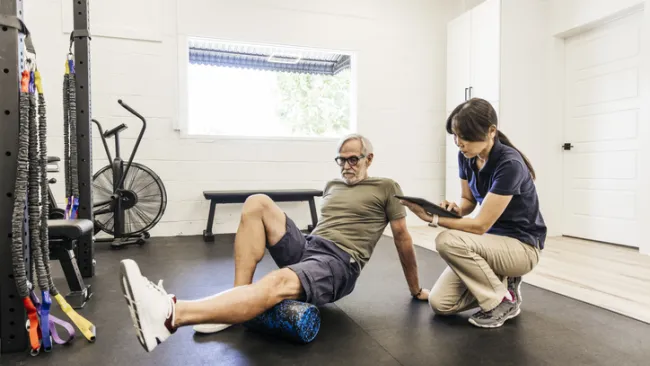What’s in a customer experience? For chief marketing officers, the answer can spell success or failure. In today’s hyper competitive business environment, even a mediocre experience could lead to disaster. CMOs are increasingly leading the charge to create top-flight experiences that keep customers engaged and returning for more.
And so, in addition to their core branding activities, chief marketing officers are focusing on the customer’s needs and expectations—and how to exceed those expectations.
We spoke with the CMOs of Pearle Vision and Tough Mudder to understand their strategies for delivering superior customer experiences, staying ahead of competitors, and what it’s like to lead CX initiatives within two very different organizations.
Eyeing the Future
Last year, Pearle Vision, the eyeglass retailer, made a radical decision: It killed off its buy-one-get-one-free (BOGOF) offers. “One of the biggest evolutions of our business was to eliminate BOGOF from our business ecosystem and brand vernacular,” says Pearle Vision VP & CMO Doug Zarkin.
Founded in 1961 by optometrist Stanley Pearle, and acquired by Luxottica Group in 2004, Pearle Vision is one of the largest franchised optical retailers in North America.
However, over the years, the brand began struggling to differentiate itself from other eyeglass retailers. Increasing competition from low-price competitors, such as Wal-Mart’s optical stores and online retailers like Warby Parker, were adding further competitive pressure.
Squeezed by competitors, Pearle Vision needed to find its footing. And so, a few years ago, Zarkin and his team reached out to Pearle locations across the U.S., most of which were franchises owned and operated by local optometrists and opticians.
The response was clear: Pearle Vision needed to return to its roots and focus on personalized, genuine eye care.
“Genuine eye care,” Zarkin told marketers at the Modern Marketing Summit, is represented by the company’s locally owned and operated franchises. About 70 percent of Pearle Vision locations are run by doctors and opticians, he said at the event. “We’re a brand that has a majority of locations owned by doctors of optometry—they’re locally owned and operated eye care centers…Eye care begins with a medical experience, and it’s the manner in which we conduct that experience that separates us.”
The fact that many of Pearle Vision’s franchise owners live and work in the communities where they operate an eye care center helps them provide a more personalized commitment to care and gives a nationwide brand a small town touch.
For instance, last year Pearle Vision hosted nearly 600 events as part of its CORNEA program (Community Outreach Neighborhood Eyecare Activations). At these events, optometrists and their staff visited senior centers, churches, synagogues, youth groups, and other community centers to offer vision screenings, eye glass cleanings, distribute eye care information, and schedule eye exams.
Such activities are important because they help potential patients “get to know the people behind our brand,” Zarkin says. “It’s those moments of decisions, where you can take that extra step to get to know your patient, to get to know your customer, those small moments where you can really begin to establish trust, that, frankly, is what’s allowing us to thrive.”
Pearle Vision’s efforts to enhance its customer engagement are also in line with a growing retail trend. As Deloitte observed in a report, The Great Retail Bifurcation, “Price-based and premier retailers are dramatically outperforming those in the middle.”
A number of factors—a shrinking middle-class, the rise of e-commerce, the commoditization of goods, and more—have contributed to the recent wave of store closures and bankruptcies. And in order to survive, “retailers will need to adapt their sales strategy and value proposition at the pace of the changing consumer and changing competition in order to succeed,” according to the report.
Or as Zarkin puts it, “shi**y retail is dead.” Anyone, he says, “could open a boutique 10 years ago in a suburb and have a reasonably good chance at being okay. That’s no longer true. Brands today are being forced to really be focused on establishing a reason for being and a purposeful retail experience.”
Which brings us back to the decision to eliminate BOGOF.
“Trust is not earned in big gestures. Giving something away for free is a big gesture,” Zarkin says. “Trust for us is about the small moments and listening to what a patient needs from the exam room to the retail floor to guide them to their perfect pair.”
And as part of its efforts to build greater customer trust, the company is also paying more attention to customer feedback. The company has “doubled down” on analyzing its Net Promoter Score and monitoring reviews to gain insights into customer needs and expectations, according to Zarkin. Front-line associates are also being asked for input on how to further improve customer interactions.
And while Pearle Vision offers products within a range of prices, offering the lowest price isn’t the only thing that customers value, Zarkin says.
“Value equals experience divided by price. The brands that succeed are the ones that optimized both the experience side, and figured out the sweet spot for what the pricing side should be, and that’s why consumers see value,” he says. “Value leads to trust, which leads to loyalty, which leads to advocacy, which leads to growth. It’s not something that we do perfectly every day, but we’re trying.”
Tough Mudder ‘is not a race’
Having a pleasant experience at an eye center is one thing. Then there are those who sign up for the experience of slogging through muddy tunnels, scaling walls, and navigating wires that emit electric shocks.
For those unfamiliar with this type of sport, Tough Mudder is an endurance event series in which participants attempt to complete 10- to 12-mile-long obstacle courses that test physical as well as mental strength.
The company was co-founded in 2010 by Will Dean, a former British counter-terrorism officer, and Guy Livingstone, a former corporate lawyer. The obstacles are designed around common human fears, such as water, fire, heights, and electricity. About 78 percent of participants successfully complete the course.
But finishing the course isn’t the point. The Tough Mudder courses emphasize teamwork, camaraderie, and community-building. The company also offers a wide range of endurance events, making them accessible to nearly everyone.
In fact, at the starting line of each course, participants chant, “the Tough Mudder is not a race, it’s a challenge,” as part of a pledge.
It’s a challenge that appeals to many people. The brand’s military-style obstacle challenges quickly expanded from the three events of its first year into more than 150 events that each year draw between 10,000 and 15,000 participants from around the world. And roughly 20,000 of those participants sport tattoos commemorating their status as tough mudders.
Such engagement doesn’t happen by itself. It requires a lot of careful planning and collaboration behind the scenes.
Tough Mudder CMO Jerome Hiquet leads global sales, marketing, and product innovation strategies, as well as content monetization, customer service, and customer acquisition and retention, among other responsibilities.
The large scope of customer-related roles that Hiquet holds underscores the notion that the customer may be in charge, but the CMO is leading the experience. In fact, Hiquet attributes this arrangement to the company’s ability to “own the whole customer experience.”
“Brands need to create a seamless experience and it helps to have someone lead the overall customer journey,” he says. “For example, the team that manages on-site customer service at the events can share heartfelt moments from participants with the content team and the product innovation teams because they’re all connected. My role facilitates a sharing of ideas between all these groups.”
Indeed, according to Gartner research, customer experience outcomes tend to “diminish when marketing or any other single department attempts to lead and execute CX alone. CX leaders need to partner and collaborate with other departments to make improvements throughout the entire client life cycle.”
Combining data from disparate sources into meaningful information is also key. Two years ago, the company committed to streamlining its data through Salesforce’s CRM platform, creating a unified view of the customer from sales transactions to customer service tickets. It was a “big project” but worthwhile “since it allows us to connect with our customers in a way that’s direct and personalized,” Hiquet says.
As a result of these efforts, Hiquet’s team launched some of the brand’s most popular events, including the Tough Mudder 5K, Tough Mudder Half, and Toughest Mudder, in addition to building an extensive brand presence with more than 5.4 million Facebook fans globally and 85 million video views on YouTube.
At the same time, the company has to make sure these experiences stay fresh. Although obstacle courses are at the heart of its brand identity, Tough Mudder is also a lifestyle and media company that reaches tens of millions of people around the world and raises millions of dollars for charity. “Innovation is key,” Hiquet says. “We’re always working on new ideas and trying new concepts.”
The company produces digital content such as pre-race, race-day, and post-race videos and guides featuring fitness and lifestyle experts that are distributed on media outlets and platforms, including CBS Sports, The CW, Snapchat, and Instagram.
Tough Mudder has also launched fitness studio franchises called Tough Mudder Bootcamp. Each Bootcamp acts as a “community center” to motivate members to achieve their fitness goals through benchmarks and Tough Mudder events. It’s also another way for the brand to stay in touch with participants outside of the obstacle courses. The company sold about a dozen franchise licenses in 2017 and set a goal of 150 by the end of 2018.
And even though extreme sports is one of the few areas that Amazon doesn’t compete in (yet), that’s not an excuse for the company to be idle, Hiquet says. “The way to compete with Amazon or any competitor is to have a strong purpose, a strong community, and maximize your touchpoints with the customer,” he says. “For us, we’re building a platform that helps ordinary people do extraordinary things and that resonates with many people.”
Conclusion
The definition of an excellent customer experience is different for every brand, but a few patterns stand out. Customers want to feel valued and know that the time and money they’re investing in a brand is worthwhile.
And as the CMOs of Pearle Vision and Tough Mudder demonstrate, this means looking past the product. They’re not selling glasses or a fitness regimen—they’re selling an experience. And the companies that are able to continue aligning those experiences with customer expectations will always come out ahead.
















